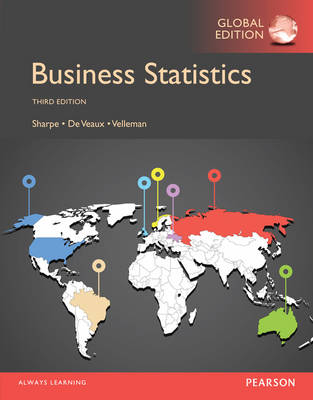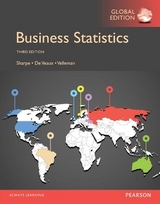
Business Statistics MyStatLab, Global Edition
Pearson Education Limited
978-1-292-07072-8 (ISBN)
- Titel erscheint in neuer Auflage
- Artikel merken
Important information for students:
You need both an access code and a course ID to access MyStatLab. Ask your lecturer before purchasing a MyLab product as you will need a course ID from them before you can gain access to the system.
This package includes MyStatLab (TM).
For courses in Business Statistics
Business Statistics, Third Edition, by Sharpe, De Veaux, and Velleman, narrows the gap between theory and practice-relevant statistical methods empower business students to make effective, data-informed decisions. With their unique blend of teaching, consulting, and entrepreneurial experiences, this dynamic author team brings a modern edge to teaching statistics to business students. Focusing on statistics in the context of real business issues, with an emphasis on analysis and understanding over computation, the text helps students be analytical, prepares them to make better business decisions, and shows them how to effectively communicate results.
This program provides a better teaching and learning experience-for you and your students. Here's how:
Grounded in modern business, this text provides a real-world context for statistical concepts, preparing students to be successful in the business world.
Practice and support: Study tools throughout the text prepare students to analyze and interpret data.
Integrated technology: Optional coverage helps students use real statistics software
NEW! Improved organization and a streamlined design make the text more accessible than ever.
Personalized learning with MyStatLab: the accompanying MyStatLab (TM) online course provides users with countless opportunities to practice, plus statistics specific resources and tools that enhance their experience and comprehension.
This package includes MyStatLab, an online homework, tutorial, and assessment program designed to work with this text to personalize learning and improve results. With a wide range of interactive, engaging, and assignable activities, students are encouraged to actively learn and retain tough course concepts.
MyStatLab should only be purchased when required by an instructor. Please be sure you have the correct ISBN and Course ID. Instructors, contact your Pearson representative for more information.
Find out more at www.MyStatLab.com.
Preface
Index of Applications
1. Data and Decisions (E-Commerce)
1.1 Data and Decisions
1.2 Variable Types
1.3 Data Sources: Where, How, and When
Ethics in Action
Technology Help: Data on the Computer
Brief Case: Credit Card Bank
2. Displaying and Describing Categorical Data (Keen, Inc.)
2.1 Summarizing a Categorical Variable
2.2 Displaying a Categorical Variable
2.3 Exploring Two Categorical Variables: Contingency Tables
2.4 Segmented Bar Charts and Mosaic Plots
2.5 Simpson's Paradox
Ethics in Action
Technology Help: Displaying Categorical Data on the Computer
Brief Case: Credit Card Bank
3. Displaying and Describing Quantitative Data (AIG)
3.1 Displaying Quantitative Variables
3.2 Shape
3.3 Center
3.4 Spread of the Distribution
3.5 Shape, Center, and Spread-A Summary
3.6 Standardizing Variables
3.7 Five-Number Summary and Boxplots
3.8 Comparing Groups,
3.9 Identifying Outliers,
3.10 Time Series Plots
3.11 Transforming Skewed Data
Ethics in Action
Technology Help: Displaying and Summarizing Quantitative Variables
Brief Cases: Detecting the Housing Bubble and Socio-Economic Data on States
4. Correlation and Linear Regression (Amazon.com)
4.1 Looking at Scatterplots
4.2 Assigning Roles to Variables in Scatterplots
4.3 Understanding Correlation
4.4 Lurking Variables and Causation
4.5 The Linear Model
4.6 Correlation and the Line
4.7 Regression to the Mean
4.8 Checking the Model
4.9 Variation in the Model and R2
4.10 Reality Check: Is the Regression Reasonable?
4.11 Nonlinear Relationships
Ethics in Action
Technology Help: Correlation and Regression
Brief Cases: Fuel Efficiency, Cost of Living, and Mutual Funds
Case Study I: Paralyzed Veterans of America
5. Randomness and Probability (Credit Reports and the Fair Isaacs Corporation)
5.1 Random Phenomena and Probability
5.2 The Nonexistent Law of Averages
5.3 Different Types of Probability
5.4 Probability Rules
5.5 Joint Probability and Contingency Tables
5.6 Conditional Probability
5.7 Constructing Contingency Tables
5.8 Probability Trees
5.9 Reversing the Conditioning: Bayes' Rule
Ethics in Action
Technology Help: Generating Random Numbers
Brief Case
6. Random Variables and Probability Models (Metropolitan Life Insurance Company)
6.1 Expected Value of a Random Variable
6.2 Standard Deviation of a Random Variable
6.3 Properties of Expected Values and Variances
6.4 Bernoulli Trials
6.5 Discrete Probability Models
Ethics in Action
Technology Help: Random Variables and Probability Models
Brief Case: Investment Options
7. The Normal and other Continuous Distributions (The NYSE)
7.1 The Standard Deviation as a Ruler
7.2 The Normal Distribution
7.3 Normal Probability Plots
7.4 The Distribution of Sums of Normals
7.5 The Normal Approximation for the Binomial
7.6 The Other Continuous Random Variables
Ethics in Action
Technology Help: Probability Calculations and Plots
Brief Case
8. Surveys and Sampling (Roper Polls)
8.1 Three Ideas of Sampling
8.2 Populations and Parameters
8.3 Common Sampling Designs
8.4 The Valid Survey
8.5 How to Sample Badly
Ethics in Action
Technology Help: Random Sampling
Brief Cases: Market Survey Research and The GfK Roper Reports Worldwide Survey
9. Sampling Distributions and Confidence Intervals for Proportions (Marketing Credit Cards: The MBNA Story)
9.1 The Distribution of Sample Proportions
9.2 A Confidence Interval
9.3 Margin of Error: Certainty vs. Precision
9.4 Choosing and Sample Size
Ethics in Action
Technology Help: Confidence Intervals for Proportions
Brief Case: Real Estate Simulation
Case Study II
10. Testing Hypotheses about Proportions (Dow Jones Industrial Average)
10.1 Hypotheses
10.2 A Trial as a Hypothesis Test
10.3 P-Values
10.4 The Reasoning of Hypothesis Testing
10.5 Alternative Hypotheses
10.6 p-Values and Decisions: What to Tell About a Hypothesis Test
Ethics in Action
Technology Help: Hypothesis Tests
Brief Cases: Metal Production and Loyalty Program
11. Confidence Intervals and Hypothesis Tests for Means (Guinness & Co.)
11.1 The Central Limit Theorem
11.2 The Sampling Distribution of the Mean
11.3 How Sampling Distribution Models Work
11.4 Gossett and the t -Distribution
11.5 A Confidence Interval for Means
11.6 Assumptions and Conditions
11.7 Testing Hypothesis about Means-the One-Sample t-Test
Ethics in Action
Technology Help: Inference for Means
Brief Cases: Real Estate and Donor Profiles
12. More About Tests and Intervals (Traveler's Insurance)
12.1 How to Think About P-Values
12.2 Alpha Levels and Significance
12.3 Critical Values
12.4 Confidence Intervals and Hypothesis Tests
12.5 Two Types of Errors
12.6 Power
Ethics in Action
Technology Help: Hypothesis Tests
Brief Case
13. Comparing Two Means (Visa Global Organization)
13.1 Comparing Two Means
13.2 The Two-Sample t-Test
13.3 Assumptions and Conditions
13.4 A Confidence Interval for the Difference Between Two Means
13.5 The Pooled t-Test
13.6 Paired Data
13.7 Paired Methods
Ethics in Action
Technology Help: Two-Sample Methods
Technology Help: Paired t
Brief Cases: Real Estate and Consumer Spending Patterns (Data Analysis)
14. Inference for Counts: Chi-Square Tests (SAC Capital)
14.1 Goodness-of-Fit Tests
14.2 Interpreting Chi-Square Values
14.3 Examining the Residuals
14.4 The Chi-Square Test of Homogeneity
14.5 Comparing Two Proportions
14.6 Chi-Square Test of Independence
Ethics in Action
Technology Help: Chi-Square
Brief Cases: Health Insurance and Loyalty Program
Case Study III: Investment Strategy Segmentation
15. Inference for Regression (Nambe Mills)
15.1 A Hypothesis Test and Confidence Interval for the Slope
15.2 Assumptions and Conditions
15.3 Standard Errors for Predicted Values
15.4 Using Confidence and Prediction Intervals
Ethics in Action
Technology Help: Regression Analysis
Brief Cases: Frozen Pizza and Global Warming?
16. Understanding Residuals (Kellogg's)
16.1 Examining Residuals for Groups
16.2 Extrapolation and Prediction
16.3 Unusual and Extraordinary Observations
16.4 Working with Summary Values
16.5 Autocorrelation
16.6 Transforming (Re-expressing) Data
16.7 The Ladder of Powers
Ethics in Action
Technology Help: Examining Residuals
Brief Cases: Gross Domestic Product and Energy Sources
17. Multiple Regression (Zillow.com)
17.1 The Multiple Regression Model
17.2 Interpreting Multiple Regression Coefficients
17.3 Assumptions and Conditions for the Multiple Regression Model
17.4 Testing the Multiple Regression Model
17.5 Adjusted R2 and the F-statistic
17.6 The Logistic Regression Model
Ethics in Action
Technology Help: Regression Analysis
Brief Case: Golf Success
18. Building Multiple Regression Models (Bolliger and Mabillard)
18.1 Indicator (or Dummy) Variables
18.2 Adjusting for Different Slopes-Interaction Terms
18.3 Multiple Regression Diagnostics
18.4 Building Regression Models
18.5 Collinearity
18.6 Quadratic Terms
Ethics in Action
Technology Help: Building Multiple Regression Models
Brief Case
19. Time Series Analysis (Whole Food Market)
19.1 What Is a Time Series?
19.2 Components of a Time Series
19.3 Smoothing Methods
19.4 Summarizing Forecast Error
19.5 Autoregressive Models
19.6 Multiples Regression-based Models
19.7 Choosing a Time Series Forecasting Method
19.8 Interpreting Time Series Models: The Whole Foods Data Revisited
Ethics in Action
Technology Help
Brief Cases: Intel Corporation and Tiffany & Co.
Case Study IV: Health Care Costs
20. Design and Analysis of Experiments and Observational Studies (Capital One)
20.1 Observational Studies
20.2 Randomized Comparative Experiments
20.3 The Four Principles of Experimental Design
20.4 Experimental Designs
20.5 Issues in Experimental Design
20.6 Analyzing a Design in One Factor-The One-Way Analysis of Variance
20.7 Assumptions and Conditions for ANOVA
20.8 Multiple Comparisons
20.9 ANOVA on Observational Data
20.10 Analysis of Multifactor Designs
Ethics in Action
Technology Help: Analysis of Variance
Brief Case: Multifactor Experiment Design
21. Quality Control (Sony)
21.1 A Short History of Quality Control
21.2 Control Charts for Individual Observations (Run Charts)
21.3 Control Charts for Measurements: (x-bar) and R Charts
21.4 Actions for Out-of-Control Processes
21.5 Control Charts for Attributes: p Charts and c Charts
21.6 Philosophies of Quality Control
Ethics in Action
Technology Help: Quality Control Charts
Brief Case: Laptop Touchpad Quality
22. Nonparametric Methods (i4cp)
22.1 Ranks
22.2 The Wilcoxon Rank-Sum/Mann-Whitney Statistic
22.3 Kruskal-Wallace Test
22.4 Paired Data: The Wilcoxon Signed-Rank Test
22.5 Friedman Test for a Randomized Block Design
22.6 Kendall's Tau: Measuring Monotonicity
22.7 Spearman's Rho
22.8 When Should You Use Nonparametric Methods?
Ethics in Action
Technology Help
Brief Case: Real Estate Reconsidered
23. Decision Making and Risk (Data Description, Inc.)
23.1 Actions, States of Nature, and Outcomes
23.2 Payoff Tables and Decisions Trees
23.3 Minimizing Loss and Maximizing Gain
23.4 The Expected Value of an Action
23.5 Expected Value with Perfect Information
23.6 Decisions Made with Sample Information
23.7 Estimating Variation
23.8 Sensitivity
23.9 Simulation
23.10 More Complex Decisions
Ethics in Action
Technology Help
Brief Cases: Texaco-Pennzoil and Insurance Services, Revisited
24. Introduction to Data Mining (Paralyzed Veterans of America)
24.1 The Big Data Revolution
24.2 Direct Marketing
24.3 The Goals of Data Mining
24.4 Data Mining Myths
24.5 Successful Data Mining
24.6 Data Mining Problems
24.7 Data Mining Algorithms
24.8 The Data Mining Process
24.9 Summary
Ethics in Action
Case Study V Marketing Experiment
Appendices
A. Answers
B. Photo Acknowledgments
C. Tables and Selected Formulas
Index
| Erscheint lt. Verlag | 20.11.2014 |
|---|---|
| Verlagsort | Harlow |
| Sprache | englisch |
| Maße | 216 x 275 mm |
| Gewicht | 1740 g |
| Themenwelt | Schulbuch / Wörterbuch |
| Mathematik / Informatik ► Mathematik ► Finanz- / Wirtschaftsmathematik | |
| Mathematik / Informatik ► Mathematik ► Statistik | |
| ISBN-10 | 1-292-07072-2 / 1292070722 |
| ISBN-13 | 978-1-292-07072-8 / 9781292070728 |
| Zustand | Neuware |
| Haben Sie eine Frage zum Produkt? |
aus dem Bereich



